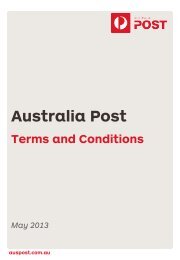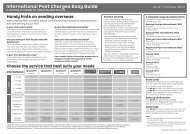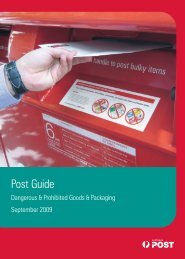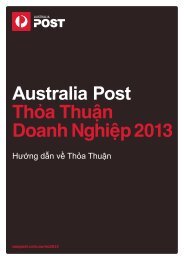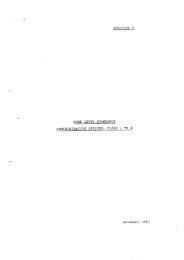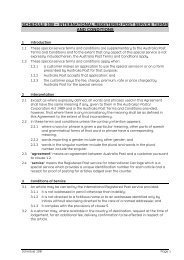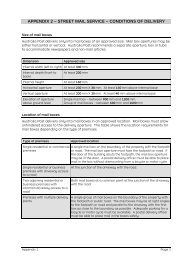stamp bulletin - Australia Post Shop
stamp bulletin - Australia Post Shop
stamp bulletin - Australia Post Shop
You also want an ePaper? Increase the reach of your titles
YUMPU automatically turns print PDFs into web optimized ePapers that Google loves.
Bush Tucker<br />
Sheet layout and tête-bêche printing<br />
The <strong>stamp</strong>s will be printed in sheets of 50,<br />
in two panes of 25, with a<br />
decorative gutter.<br />
The design takes advantage<br />
of the tête-bêche printing<br />
format, using it to enhance the<br />
impact of the designs.<br />
Tête-bêche printing alone might generate some<br />
interest. It is not used as commonly as it once<br />
was. When combined with the striking <strong>stamp</strong><br />
designs and some subtle design flourishes, this<br />
Bush Tucker issue should spark interest and<br />
study amongst committed collectors in<br />
<strong>Australia</strong> and overseas.<br />
For example: the design<br />
bleeds into the selvedge at the<br />
top and bottom of the sheet.<br />
The gutter design bleeds<br />
into the selvedge of the adjacent<br />
<strong>stamp</strong>s.<br />
The bush banana motif which runs through<br />
the gutter (and at the top of the facing page) is<br />
directional. The bananas hang ‘down’ thus<br />
defining the sheet’s top and bottom.<br />
The individual <strong>stamp</strong>s and the design set<br />
itself make their visual statements when viewed<br />
in isolation. As well they can be visually combined<br />
with their tête-bêche ‘partners’ to create<br />
additional views.<br />
Looking at multiple <strong>stamp</strong>s in the sheet, the<br />
designs can be visualised as columns or rows.<br />
Tête-bêche pairs dissolve into a single large<br />
design, tête-bêche rows produce dramatic<br />
blocks. The role layout plays in the perception<br />
of the designs is most dramatically illustrated in<br />
the full sheet.<br />
The sheet is shown against a black background<br />
to make it easier to see the perforations,<br />
selvedges and other design features.<br />
8<br />
Figure 1<br />
Figure 2<br />
Figure 3 Sequence A used for covers<br />
Figure 4 Sequence B, used in packs<br />
Double gutter strip<br />
Standard products and sequences<br />
This sheet of 50 <strong>stamp</strong>s produces ten<br />
(horizontal) se-tenant strips in two alternating<br />
sequences (A and B).The two sequences<br />
(Figures 3 and 4) and the individual strips<br />
alternate along the length of the sheet.<br />
Sequence A<br />
Lilly-pilly, Honey grevillea,<br />
Quandong, Acacia,<br />
Murnong<br />
Sequence B<br />
Murnong, Acacia,<br />
Quandong, Honey<br />
grevillea, Lilly-pilly,<br />
Booklet of ten x 49c, not tête-bêche<br />
Sequence B will be used in <strong>stamp</strong> packs. This is<br />
the only pack configuration available. Standard<br />
covers will be produced with Sequence A.<br />
Standing orders for design sets, covers and<br />
gutter strips will be supplied as follows:<br />
Design set<br />
se-tenant strip of five x 49c randomly from Sequence A/B<br />
without regard to selvedge or sheet position<br />
Cover<br />
with a se-tenant strip of five x 49c in Sequence A<br />
Gutter strip<br />
standard ten x 49c gutter strip<br />
Standing order customers who want other<br />
configurations should contact the <strong>Australia</strong>n<br />
Philatelic Bureau and amend their orders<br />
before 23 August 2002.<br />
Self-adhesive <strong>stamp</strong>s<br />
Unlike the gummed <strong>stamp</strong>s, the self-adhesive<br />
<strong>stamp</strong> in the booklets of ten x 49c are se-tenant<br />
vertically (see above). <strong>Post</strong> will not produce<br />
covers for the self-adhesive <strong>stamp</strong>s.<br />
9




